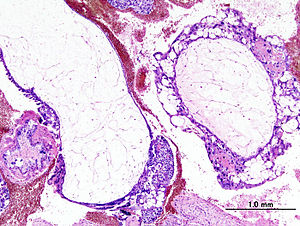Hydatidiform mole
| Hydatidiform mole | |
|---|---|
 |
|
| Histopathologic image of hydatidiform mole (complete type). H & E stain. | |
| Classification and external resources | |
| Specialty | oncology |
| ICD-10 | O01, D39.2 |
| ICD-9-CM | 630 |
| ICD-O | M9100/0 |
| OMIM | 231090 |
| DiseasesDB | 6097 |
| MedlinePlus | 000909 |
| eMedicine | med/1047 med/866 |
| MeSH | D006828 |
Molar pregnancy is an abnormal form of pregnancy in which a non-viable fertilized egg implants in the uterus and will fail to come to term. A molar pregnancy is a gestational trophoblastic disease which grows into a mass in the uterus that has swollen chorionic villi. These villi grow in clusters that resemble grapes. A molar pregnancy can develop when a fertilized egg does not contain an original maternal nucleus. The products of conception may or may not contain fetal tissue. It is characterized by the presence of a hydatidiform mole (or hydatid mole, mola hydatidosa). Molar pregnancies are categorized as partial moles or complete moles, with the word mole being used to denote simply a clump of growing tissue, or a growth.
A complete mole is caused by a single (incidence is about 90%) or two (incidence is about 10%) sperm combining with an egg which has lost its DNA (the sperm then reduplicates forming a "complete" 46 chromosome set). The genotype is typically 46,XX (diploid) due to subsequent mitosis of the fertilizing sperm, but can also be 46,XY (diploid). 46,YY (diploid) is not observed. In contrast, a partial mole occurs when a haploid egg is fertilized by two sperm or by one sperm which reduplicates itself yielding the genotypes of 69,XXY (triploid) or 92,XXXY (tetraploid). Complete hydatidiform moles have 2.5% risk of developing into choriocarcinoma, but also a 10% chance of becoming an invasive mole. Incomplete moles can become invasive (<5% risk) but are not associated with choriocarcinoma. Complete hydatidiform moles account for 50% of all cases of choriocarcinoma.
Molar pregnancies usually present with painless vaginal bleeding in the fourth to fifth month of pregnancy. The uterus may be larger than expected, or the ovaries may be enlarged. There may also be more vomiting than would be expected (hyperemesis). Sometimes there is an increase in blood pressure along with protein in the urine. Blood tests will show very high levels of human chorionic gonadotropin (hCG).
...
Wikipedia
